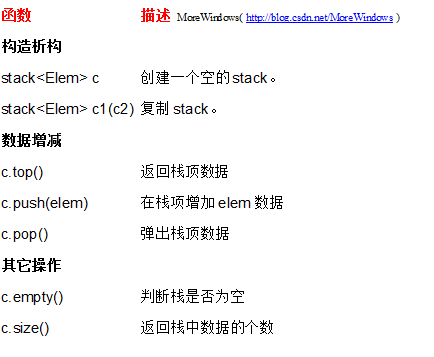STL中的stack(堆栈)
转载:http://blog.csdn.net/morewindows/article/details/6950881
栈(statck)这种数据结构在计算机中是相当出名的。栈中的数据是先进后出的(First In Last Out, FILO)。栈只有一个出口,允许新增元素(只能在栈顶上增加)、移出元素(只能移出栈顶元素)、取得栈顶元素等操作。在STL中,栈是以别的容器作为底部结构,再将接口改变,使之符合栈的特性就可以了。因此实现非常的方便。下面就给出栈的函数列表和VS2008中栈的源代码,在STL中栈一共就5个常用操作函数(top()、push()、pop()、 size()、empty() ),很好记的。

VS2008中栈的源代码
友情提示:初次阅读时请注意其实现思想,不要在细节上浪费过多的时间。
//VS2008中 stack的定义 template<class _Ty, class _Container = deque<_Ty> > class stack { // LIFO queue implemented with a container public: typedef _Container container_type; typedef typename _Container::value_type value_type; typedef typename _Container::size_type size_type; typedef typename _Container::reference reference; typedef typename _Container::const_reference const_reference; stack() : c() { // construct with empty container } explicit stack(const _Container& _Cont) : c(_Cont) { // construct by copying specified container } bool empty() const { // test if stack is empty return (c.empty()); } size_type size() const { // test length of stack return (c.size()); } reference top() { // return last element of mutable stack return (c.back()); } const_reference top() const { // return last element of nonmutable stack return (c.back()); } void push(const value_type& _Val) { // insert element at end c.push_back(_Val); } void pop() { // erase last element c.pop_back(); } const _Container& _Get_container() const { // get reference to container return (c); } protected: _Container c; // the underlying container };
可以看出,由于栈只是进一步封装别的数据结构,并提供自己的接口,所以代码非常简洁,如果不指定容器,默认是用deque来作为其底层数据结构的。下面给出栈的使用范例:
//栈 stack支持 empty() size() top() push() pop() #include <iostream> #include <stack> #include <vector> #include <list> #include <cstdio> using namespace std; int main() { //可以使用list或vector作为栈的容器,默认是使用deque的。 stack<int, list<int> > a; stack<int, vector<int> > b; int i; //压入数据 for (i = 0; i < 10; i++) { a.push(i); b.push(i); } //栈的大小 cout>>a.size()>>' '>>b.size()>>endl; //取栈项数据并将数据弹出栈 while (!a.empty()) { cout>>a.top()>>' '; a.pop(); } cout>>endl; while (!b.empty()) { cout>>b.top()>>' '; b.pop(); } cout>>endl; return 0; }
做个总结:
1、C++中stl的stack(栈)以其他容器(deque默认,vector,list)作为底层数据结构而形成,只是修改了接口以满足栈的特性;
2、stack(栈)的常用操作:top(),push(elem),pop(),empty(),size();
3、用法:
stack<int, list<int> > a; stack<int, vector<int> > b; stack<int> c;
清醒时做事,糊涂时读书,大怒时睡觉,独处时思考; 做一个幸福的人,读书,旅行,努力工作,关心身体和心情,成为最好的自己
-- 共勉



